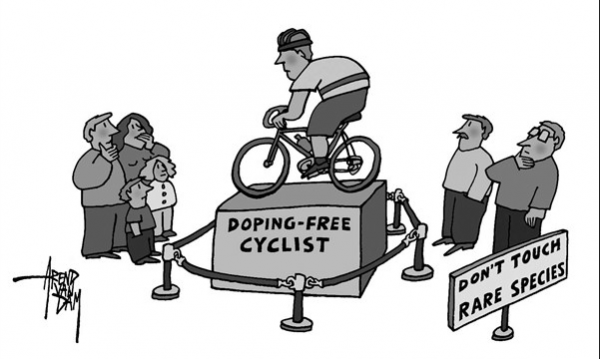How Doping Works

Doping has long been a problem in the world of amateur and professional cyclists. Recently doping has received a lot of attention, especially over the last decade in which 7 time Tour de France winner Lance Armstrong confessed to doping throughout his career. The subject of doping has generated thousands of books, articles, reports, and investigations. Here we’ll have a closer look at how doping works.
The Definition of Doping
There are several ways to define doping but the simplest definition is this: doping is the act of introducing substances (both synthetic and natural) into your body to artificially boost athletic performance. Nearly all of these substances are banned and have recognized negative health effects.
The Types Of Doping
Some types of doping are more common than others. And some types of doping are vastly more dangerous than others. The main substances used by cyclists for doping most often are:
- EPO (erythropoietin)
- Blood Doping
- Human Growth Hormone (HGH)
- Pharmacological, chemical, and physical manipulation
- Steroids
- Stimulants
- Gene doping
- Amphetamines
- Narcotic Analgesics
- Diuretics
EPO And Blood Doping
EPO was first used on patients in the late 1980s to increase the body’s capacity for oxygen transfer by signaling the body to produce more red blood cells. It was quickly commandeered by athletes to increase their performance by artificially boosting their red blood cell count. A test for detecting EPO doping was first used in 2000 when EPO was a very large problem.
Blood doping is similar to EPO. With blood doping an athlete will have their own blood that is high in red blood cells removed and stored until it is re-injected back into their own body at a later date when their red blood cell count is lower, instantly resulting in a higher red blood cell count in the athlete’s blood.
Both of these methods cause a direct increase in performance by allowing more oxygen to be delivered to the muscles. However, using too much EPO interferes with the body’s natural blood production to the point that the athlete can become dependent on EPO for the rest of their life. Likewise, straight blood doping can cause illnesses, clots, and a thickening of the blood that puts massive strain on the heart.
HGH, Steroids, Stimulants
HGH is well known as a means for athletes to boost performance. The hormone boosts cell growth and helps build muscle mass and helps muscles recover more quickly which aids you during training and competition. However, abusing HGH can cause bone thickening, swollen hands and feet, and enlarged organs which can be fatal if not caught early enough. There are currently no accurate tests for HGH doping.
Steroids enhance muscle growth and the production of EPO while others increase competitiveness and aggression to allow for longer and harder training. The common side effects of steroids include kidney damage, impotence, mood swings, and severe liver damage. Males have been known to grow breasts and females have grown facial hair and developed deep voices as a result of using steroids.
Stimulants work to increase energy and awareness to allow athletes to compete at higher levels for longer. They get rid of the feeling of tiredness and cause weight loss. However, they can cause insomnia, tics, and can quickly become more detrimental than helpful to performance.
Gene Doping
Gene doping is the idea that you can alter your very DNA in the hopes that your body will start to produce more EPO without regular injections or prodding from outside sources. While not in use yet, officials believe that this is where cheaters will look to next because it is undetectable and registers as natural.
Amphetamines, Narcotic Analgesics, Diuretics
Amphetamines are less popular for doping cyclists and are usually a last resort. You’ve probably heard it called crank or speed. Users of amphetamines are more alert and energetic. However, amphetamines are forever linked to the death of Tom Simpson at the Tour de France in 1967. Simpson died of heart failure caused by dehydration, heat exhaustion, physical stress, and amphetamines.
Narcotic analgesics include both morphine and heroine and are used to increase the pain threshold. This allows athletes to push through more pain and train longer and harder, as well as compete with more ferocity. However, these drugs are highly addictive and cause loss of coordination, nausea, fainting, and comas. They are also easily detectable so most users don’t get away with it for long.
Lastly, diuretics eliminate fluids from the body resulting in weight loss. They are also very handy in hiding the presence of other banned substances in the body by increasing how much you urinate and therefore increasing the rate of expulsion of drugs in your system. However, they cause dehydration and kidney failure. They are also easily detectable.
Beating The Tests
Pharmacological, chemical, and physical manipulation is a reference to how athletes hide banned substances in their system or even alter the composition of their urine. Common methods for beating the doping test are:
- Using someone else’s urine
- Epitestosterone
- Bromantan
- Diluted urine
- Hemodilution
- Reducing kidney tubular secretions
- Manipulation of Testosterone/Epitestosterone ratio
Most of these methods are very dangerous because they manipulate, destroy, or otherwise alter the body’s natural processes.
Doping is dangerous because of the manipulation of the body’s natural processes. Not only do dopers risk their own lives, they risk their careers, titles, and respect in the sport of cycling, and on top of that they are destroying the sport and its reputation.